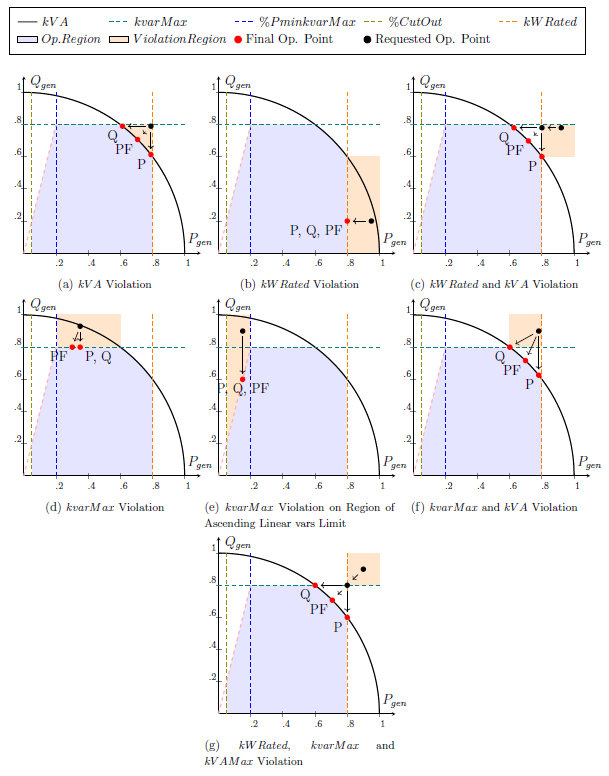Violation of Inverter Capability Curve Limits
Whenever the total complex power determined by the combination of the available (for PVSystem) or the desired (for Storage) active power output and the reactive power resulting from the application of the functions described in this document exceeds the inverter capability curve, OpenDSS ensures that it will return to the allowed operating region. This “returning” can be controlled by the user by assigning different priorities. There are three types of priorities: active power, reactive power, and power factor. They can be selected through two parameters of the PCE:
- WattPriority [Yes|No or True|False]: If set to True, priority is given to active power. If set to False, priority is given to reactive power. Defaults to False.
- PFPriority [Yes|No or True|False]: If set to True, priority is given to power factor and WattPriority is neglected. It works only if operating in either constant PF or constant kvar modes. Defaults to False.
Depending on the region where the desired complex power is located, different priorities lead to different final operating points, as follows:
- kV A Violation: The desired active and reactive power are less than their limits, kvarMax and kWRated, respectively. In this case, all three priorities are applicable, as shown in Figure 4a.
- kWRated Violation: The final operating point will be on the kWRated axis regardless the priority selected, as shown in Figure 4b. If either VW or Limit DER Power Output functions are also active, the most restricting limit applies.
- kWRated and kV A Violation: In this region, first the active power output is limited by kWRated, and then, the same rules apply as for kV A violation case. If WattPriority is set to True, the final operating point will be at the intersection of kV A and kWRated, as shown in Figure 4c.
- kvarMax Violation: In this region, only active power and power factor priorities apply. In both cases the final reactive power is limited by kvarMax, as shown in Figure 4d.
- Reactive Power Violation on Region of Ascending Linear Limit: The power factor priority is not applicable in the region of ascending linear reactive power limit because the limit crosses the complex plane origin. Thus, only active power priority applies, as shown in Figure 4e.
- kvarMax and kV A Violation: In this region, first the reactive power output is limited by kvarMax, and then, the same rules apply as for kV A violation case. With WattPriority set to False, the final operating point will be at the intersection of kV A and kvarMax, as shown in Figure 4f.
- kWRated, kvarMax and kV A Violation: First, kWRated limit is applied, then kvarMax, and finally, kV A. The final operating point will be at the intersection of kV A and kWRated if WattPriority is True, and at the intersection of kV A and kvarMax if WattPriority is False, as shown in Figure 4g.

Figure 4: Response for Violations in Different Regions of the Inverter Capability Curve and for Different Priorities
